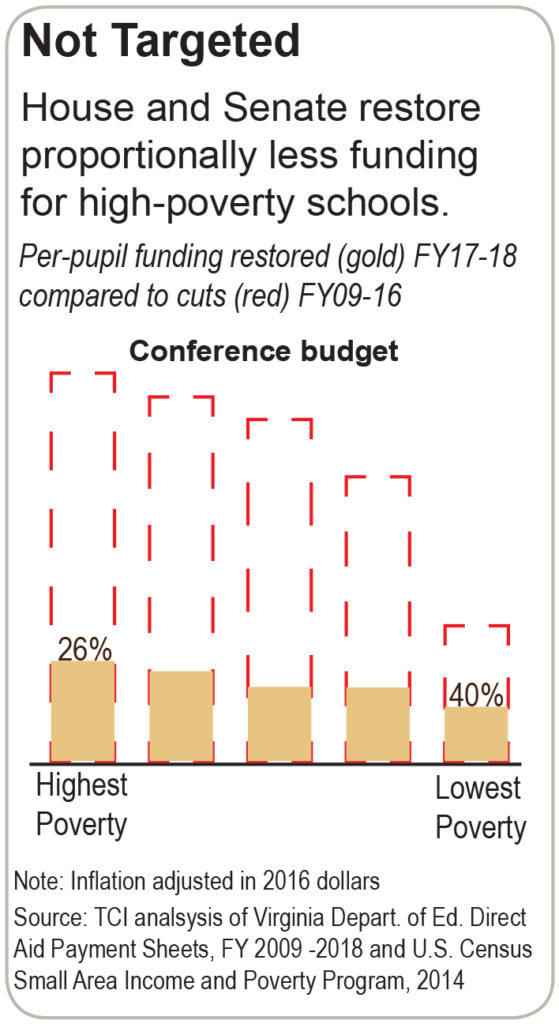March 28, 2016
Missing the Mark in School Support
Proportionately Less Funding Restored for High-Poverty School Divisions
Virginia’s Senate and House approved a two-year budget that takes an important step forward by partially restoring support for public schools after many years of significant cuts. Unfortunately, the legislature did not appropriately target the help to school divisions in high-poverty communities that sustained the largest cuts.
Recent per-pupil reductions in state aid were almost three times larger in school divisions with the highest percentages of students living in poverty compared to those with the fewest students in poverty.
The investments included in the two-year state budget that lawmakers recently approved will restore proportionately less funding for high-poverty school divisions relative to recent cuts. The conference budget agreed to by the House and Senate would restore 40 percent of recent cuts for school divisions in the wealthier parts of the state, and only 26 percent of the cuts to school divisions in the poorest areas, adjusting for inflation.
So while the new budget takes one step forward, more is needed in the years to come to repair the state’s education funding formula by undoing the structural changes made during the recession. Importantly, this would put dollars back in school divisions the same way they took them out and put Virginia on a track to more appropriate long-term funding for schools.
Recession Era Cuts Worst for High-Poverty School Divisions
The state reduced support for Virginia’s schools during the recession as part of broad cuts in state services as state revenues declined. These reductions added up to $800 million per year in cuts since 2009 (after adjusting for inflation), and that doesn’t take into account growing student enrollment. The state made these cuts through structural changes to the funding formula – like limiting the number of support positions the state will help pay for at levels below the number of staff schools truly need, eliminating support for certain equipment and staff travel, and ignoring inflation, among other changes.
These cuts left schools scrambling to balance their budgets, cutting or not filling positions for teachers and other essential staff, increasing class sizes in many schools, and deferring needed school maintenance. They also forced localities to go further above and beyond their required funding from the state.
And these cuts were not evenly distributed across Virginia’s school divisions.
In school divisions with the highest percent of students living in poverty, state cuts were almost three times larger than in divisions with the fewest students in poverty. The cuts to high-poverty school divisions from 2009 to 2016 were $1,267 per student after adjusting for inflation, compared to $440 per student in the lowest-poverty school divisions.
This difference is due to the fact that in high-poverty areas the state takes on a larger share of the costs than local governments because the localities have less ability to pay. The rationale for splitting costs this way might make sense. In practice, though, it means that each time the state cuts the education funding formula – as happened during the recession – it disproportionately hurts school divisions in high-poverty communities.
New Investments Help, But Don’t Target High-Poverty School Divisions
The two-year budget agreed upon by the House and Senate for 2017-2018 invests an additional $865 million in support for Virginia’s preK-12 schools. This boost is an important step forward, but in real dollars it does not get us back to where we were before the recession. Even with the bump, state per pupil support is still $583 below where it was in 2009, equal to a 10 percent drop, adjusting for inflation. In addition, many of the investments are not included in the funding formula. This means that while the state made structural and ongoing cuts to education funding, they made many non-structural restorations that could be temporary.
Statewide, the new investments restore 27 percent of what was cut during the recession, adjusting for inflation. But not all school divisions benefit equally. Many of the new investments are made outside the funding formula, and some are not distributed based on local ability to pay, which would target higher-poverty areas
As a result, the investments in the new budget restore proportionately less funding to high-poverty school divisions than divisions in wealthier communities. The conference budget restores just 26 percent of the cuts for the highest poverty school divisions, adjusting for inflation. By comparison, it restores 40 percent of the cuts for the lowest-poverty divisions. And it wasn’t just the poorest school divisions that got less back. In fact, most school divisions only had 26 percent or less of their funding restored. It was only in the fifth of school divisions with the fewest students in poverty that got a higher percent back. That means most school divisions in Virginia saw only about a quarter of their funding restored, while the wealthiest school divisions fared substantially better.
Fixing the Funding Formula
Lawmakers should look to fix many of the structural changes they made to the state’s funding formula during the recession. Restoring support for schools through the formula will put money back in the school divisions similar to how they took it out and will help ensure that school divisions benefit more proportionately to the harm they endured during the recession.
Another reason to fix the state education funding formula is so it can accurately reflect the true cost of educating students. The changes made during the recession diluted that accuracy by deliberately lowering the cost to the state during a time of financial strain. Without fixing the source of the problem, every budget cycle lawmakers may opt to allocate additional dollars to keep schools afloat, or if they have other priorities, they may choose not to and leave schools scrambling to fill the hole.
Lawmakers dug the hole in education funding over several budgets and it will take time to get all the way out. Yet, this needs to be a priority in the years to come so that schools can put teachers back in the classroom, shrink class sizes, renovate deteriorating facilities, and educate and train our students for successful careers that will grow our economy. Let’s fix the formula and put Virginia back on track to more appropriately funding schools.


